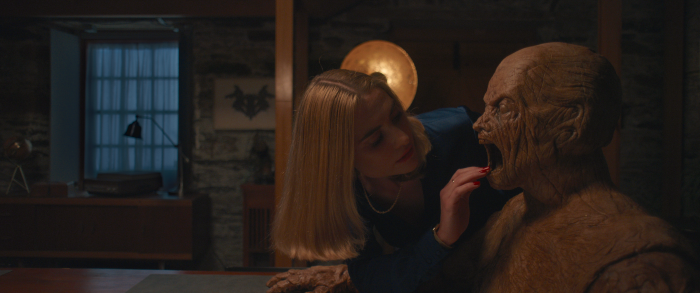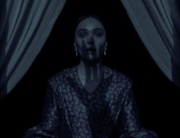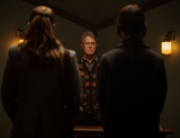In rural Ireland, Darcy (Carolyn Bracken), a blind medium, ventures to the home of her twin sister Dani (also played by Bracken) to try to unlock the mystery of Dani’s violent murder with the aid of an eerie life-size wooden mannequin from Darcy’s curio shop of cursed items. (Think the Warrens’ Occult Museum from “The Conjuring” universe, except here the items are for sale.) With her short ice blond bob and sense of determination, there’s a steeliness to Darcy as she tries to discover her sister’s killer. She’s in contrast to her late sister’s husband, Ted (Gwilym Lee), a doctor at a nearby mental hospital, and his glib new girlfriend Yana (Caroline Menton). A stock character in these kinds of horror tales, Ted is a particularly irritating, self-professed doubter of all things paranormal and supernatural.
Irish writer/director Damien McCarthy keenly utilizes some familiar horror tropes. Shot in West Cork, the setting is mostly within the old house Dani was renovating before her murder—a square-shaped manor with a large courtyard in its center. (Overhead shots of the estate are especially effective, and perhaps the movie’s most striking images.) Colm Hogan’s cinematography captures the high-ceilinged, unfinished rooms with dank brick walls—the darkness and draftiness are palpable. Other highlights are the spooky visuals and simple artifacts, like a haunted reception bell that conjures a dead bellhop of a bygone hotel, that emerge throughout. The centerpiece wooden mannequin, with its bald head and mouth agape as if frozen in mid-scream, is reminiscent of the titular creepy medical dummy of Sandor Stern’s 1988 Pin.
While McCarthy’s gothic tale is handsomely crafted, it’s a bit stodgy and sluggish too. With its folk tale elements of ghosts, curses, and the otherworld, the story has a somewhat old-fashioned storyline, simplistic and thin, its core mystery at the center unsurprising. (Could it have packed more of a wallop at an even briefer running time, even at 98 minutes?) Perhaps it would have been better suited as a slice within an anthology, in the vein of George A. Romeo’s Creepshow (1982), Dan Curtis’s Dead of Night (1977), or Dario Argento’s The Cat o’Nine Tails (1971). Or maybe a faster pace: Darcy’s dialogue, in particular, is often wan and ploddingly delivered. It’s not really the fault of Bracken, who expresses ease in portraying the two sisters, but perhaps the director’s occasional inclination toward portentousness. Still, with his affinity for macabre props and a shadowy, memorable setting, there is much to appreciate aesthetically in McCarthy’s slow burn chiller.

















Leave A Comment